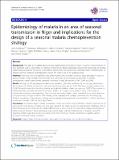Epidemiology of malaria in an area of seasonal transmission in Niger and implications for the design of a seasonal malaria chemoprevention strategy
Author(s)
Guillebaud, Julia; Mahamadou, Aboubacar; Zamanka, Halima; Katzelma, Mariama; Arzika, Ibrahim; Ibrahim, Maman L; Duchemin, Jean-Bernard; Eltahir, Elfatih A. B.; Labbo, Rabiou; Druilhe, Pierre; Fandeur, Thierry; ... Show more Show less
Download1475-2875-12-379.pdf (406.6Kb)
PUBLISHER_CC
Publisher with Creative Commons License
Creative Commons Attribution
Terms of use
Metadata
Show full item recordAbstract
Background:
Few data are available about malaria epidemiological situation in Niger. However, implementation of new strategies such as vaccination or seasonal treatment of a target population requires the knowledge of baseline epidemiological features of malaria. A population-based study was conducted to provide better characterization of malaria seasonal variations and population groups the most at risk in this particular area.
Methods:
From July 2007 to December 2009, presumptive cases of malaria among a study population living in a typical Sahelian village of Niger were recorded, and confirmed by microscopic examination. In parallel, asymptomatic carriers were actively detected at the end of each dry season in 2007, 2008 and 2009.
Results:
Among the 965 presumptive malaria cases recorded, 29% were confirmed by microscopic examination. The incidence of malaria was found to decrease significantly with age (p < 0.01). The mean annual incidence was 0.254. The results show that the risk of malaria was higher in children under ten years (p < 0.0001). The number of malaria episodes generally followed the temporal pattern of changes in precipitation levels, with a peak of transmission in August and September. One-thousand and ninety subjects were submitted to an active detection of asymptomatic carriage of whom 16% tested positive; asymptomatic carriage decreased with increasing age. A higher prevalence of gametocyte carriage among asymptomatic population was recorded in children aged two to ten years, though it did not reach significance.
Conclusions:
In Southern Niger, malaria transmission mostly occurs from July to October. Children aged two to ten years are the most at risk of malaria, and may also represent the main reservoir for gametocytes. Strategies such as intermittent preventive treatment in children (IPTc) could be of interest in this area, where malaria transmission is highly seasonal. Based on these preliminary data, a pilot study could be implemented in Zindarou using IPTc targeting children aged two to ten years, during the three months of malaria transmission, together with an accurate monitoring of drug resistance.
Date issued
2013-10Department
Massachusetts Institute of Technology. Department of Civil and Environmental Engineering; Parsons Laboratory for Environmental Science and Engineering (Massachusetts Institute of Technology)Journal
Malaria Journal
Publisher
BioMed Central Ltd.
Citation
Guillebaud, Julia, Aboubacar Mahamadou, Halima Zamanka, et al. "Epidemiology of Malaria in an Area of Seasonal Transmission in Niger and Implications for the Design of a Seasonal Malaria Chemoprevention Strategy." Malaria Journal 12(1): 379. (2013), p.1-9.
Version: Final published version
ISSN
1475-2875